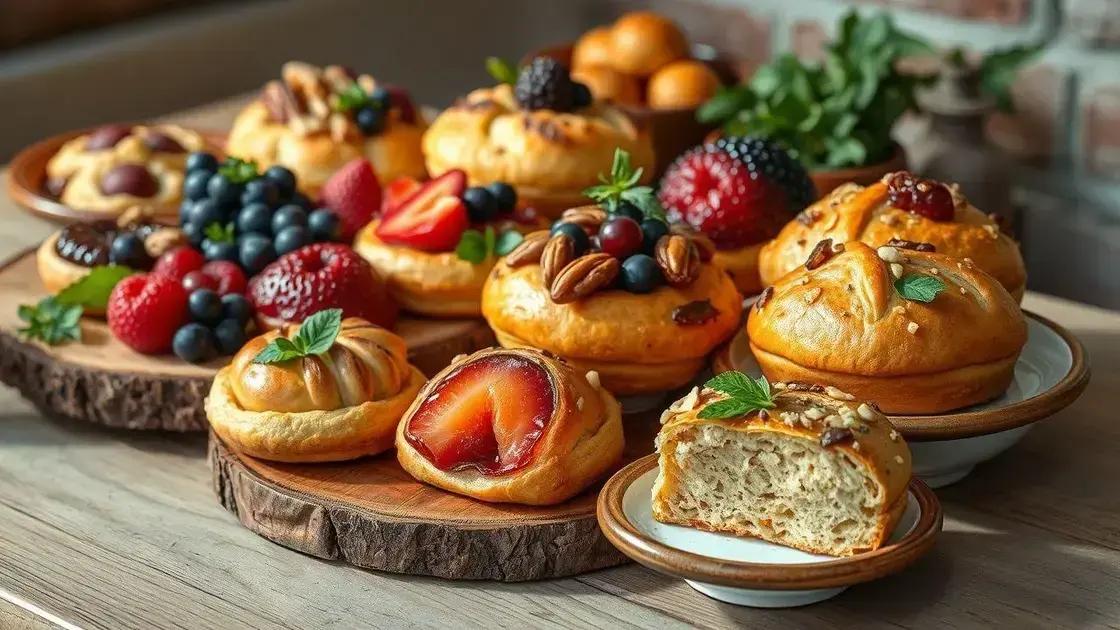Pastry chef blends cultures through innovative donut creations

Anúncios
Pastry chefs blend cultures through innovative donut creations, utilizing local ingredients, customer feedback, and unique flavor combinations to craft memorable treats that resonate with diverse tastes.
Pastry chef blends cultures through innovative donut creations that tantalize our taste buds. Have you ever wondered how a simple treat can bring together diverse traditions? Let’s dive into the world of creative donuts!
Anúncios
The art of cultural fusion in pastry
The art of cultural fusion in pastry has transformed how we perceive traditional desserts. By bringing together unique elements from different culinary heritages, pastry chefs can create unforgettable flavors and textures. Understanding this art form helps us appreciate the craft that goes into each creation.
Exploring Cultural Influences
Many pastry chefs draw inspiration from their backgrounds. This fusion leads to innovative desserts that tell a story. For instance, think of Japanese mochi combined with French éclairs. Such combinations surprise our palate and reflect the beauty of diversity.
Anúncios
Key Elements of Fusion Pastry
- Utilizing traditional ingredients in new ways
- Incorporating diverse cooking techniques
- Creating unexpected flavor profiles
- Highlighting cultural stories in each dessert
Each creation allows chefs to showcase their heritage while respecting and celebrating others. This practice of cultural fusion not only enhances the pastry landscape but also creates connections between people. Imagine biting into a tiramisu donut that blends Italian classic flavors with an American favorite. It’s this blending that invites curiosity and joy.
The Impact on the Culinary Scene
As chefs experiment, the dessert landscape becomes richer. The impact goes beyond flavors; it builds community. Customers seek out these adventurous pastries, eager to taste the unexpected. This exchange encourages culinary growth, inspiring future pastry chefs to explore their own roots and those of others.
Through the art of cultural fusion, we see pastry not just as food but as a medium for storytelling. Each bite transports us to a new place, enriching our understanding of different cultures and flavors.
Unique flavor combinations in donuts
Exploring unique flavor combinations in donuts opens up a world of creativity. Donuts are no longer just sugary rings; they can be inventive and exciting. Imagine biting into a donut that merges unexpected ingredients. This innovation satisfies traditional tastes while introducing new ones.
Creative Flavor Pairings
Chefs are experimenting with flavors that blend contrasting profiles. For example, pairing spicy chocolate with coconut cream offers a delightful kick. Another exciting combination is lavender and lemon, crafting a donut that is both fragrant and refreshing.
Popular Fusion Ideas
- Maple syrup and bacon for sweet and savory
- Matcha and white chocolate for a unique green treat
- Peanut butter and jelly for a nostalgic twist
- Italian tiramisu flavors in a fluffy donut
These combinations entice customers to try something new while enjoying familiar tastes. The journey doesn’t end here; seasonal ingredients inspire even more creativity. Imagine a pumpkin spice donut topped with maple glaze during autumn.
Pairing flavors also creates an emotional connection. When people share unique treats with friends and family, it forms memories. Each bite tells a story, inviting others to join in the experience. This sense of connection turns a simple snack into a shared celebration.
The Impact of Unique Flavors on Sales
Innovation drives excitement in the donut industry. Bakeries that offer unique flavor combinations attract more customers eager to try the latest creations. This approach not only boosts sales but also encourages customer loyalty. When people know they can find exciting new flavors, they return for more.
Incorporating local ingredients into pastry creations

Incorporating local ingredients into pastry creations is a wonderful way to celebrate regional flavors. By using fresh, local produce in baking, pastry chefs can enhance the taste and connect with their community. This practice not only supports local farmers but also creates unique tastes that represent the area.
Benefits of Using Local Ingredients
Using local ingredients provides numerous advantages. First, freshness is key; local products often taste better since they are harvested at their peak. Additionally, sourcing ingredients from nearby farms helps reduce the carbon footprint, making it more environmentally friendly. Here are a few key benefits:
- Supports the local economy
- Encourages seasonal eating
- Promotes sustainability and reduces waste
- Enhances flavor and quality in pastries
When chefs showcase local ingredients, they tell a story of the region. For example, using berries from a nearby farm in a pie highlights the abundance of the area. Such choices create a sense of place, inviting people to discover and appreciate local culture through food.
Examples of Local Ingredients in Pastries
Many regions have signature ingredients that can transform a pastry. Consider using citrus fruits in coastal areas or maple syrup in regions known for their sugar shacks. These ingredients can inspire various creations, from lemon tarts to maple-glazed donuts, each tied to the local landscape.
By promoting local ingredients, pastry chefs can foster a creative dialogue with their customers. People love to learn about where their food comes from, and sharing this knowledge creates an enriching experience. Customers feel more connected to dishes when they recognize the source of the ingredients.
Seasonal Menus and Community Engagement
Implementing local ingredients often leads to seasonal menus that change over time. This keeps the offerings fresh and exciting while encouraging customers to return for new experiences. Farmers’ markets also provide a great way to source ingredients and engage with the community, allowing chefs to meet the producers and learn about their practices.
Incorporating local ingredients into pastries is more than just a trend; it’s a commitment to quality, community, and sustainability. Chefs who embrace this practice can create delicious pastries that tell a story, delighting customers and supporting the local economy.
Crafting the perfect donut texture
Crafting the perfect donut texture is an art that every pastry chef strives to master. A donut should have a light and fluffy interior while boasting a slightly crisp exterior. Achieving this balance is essential for making memorable donuts that please customers.
The Science of Donut Dough
The key to great texture lies in the dough. A proper yeast donut requires the right amount of yeast, which helps the dough rise. This fermentation process creates air pockets, giving the donuts that fluffy texture. But timing is everything; allowing the dough to rise for just the right amount of time can transform an ordinary donut into something extraordinary.
Important Components for Texture
- Use high-quality flour to ensure the right structure.
- Incorporate eggs for richness and moisture.
- Control the frying temperature for a perfect golden crust.
- Consider the addition of milk or buttermilk for added flavor and tenderness.
The dough must also be mixed just enough; over-mixing can lead to tough donuts. Once the dough is formed, proper kneading helps develop the gluten, contributing to that desirable chewiness.
Frying Techniques
Frying is another crucial step in crafting the perfect donut texture. Maintaining a consistent oil temperature ensures that the outside cooks properly while preventing the inside from becoming excessively greasy. Donuts should float in the oil, creating a light, airy bite.
After frying, letting the donuts cool on a wire rack helps maintain that perfect texture by allowing excess oil to drip away. This step is vital; soggy donuts can ruin the experience.
Experimenting with Variations
Different types of donuts, like cake donuts or filled varieties, require unique techniques. Cake donuts often use baking powder instead of yeast, which changes the texture to be denser and crumblier. Experimenting with flavors and textures allows pastry chefs to create distinct experiences for customers.
By focusing on the crafting process and understanding the science behind it, chefs can consistently produce donuts that delight the senses. The right texture elevates donuts from a simple treat to a gourmet experience that keeps customers coming back for more.
Customer feedback and the evolution of flavors
Customer feedback plays a vital role in shaping the evolution of flavors in pastries, especially donuts. Listening to what customers have to say can transform a bakery and its offerings. Chefs are always looking to innovate and improve, and feedback provides the insights they need.
The Importance of Customer Input
When customers share their thoughts on flavor combinations, it opens the door for experimentation. For example, if many people rave about a chocolate and chili donut, a chef may decide to explore even more spicy options. This type of input can guide flavor development and inspire new creations that delight the palate.
Engaging with Customers
- Encouraging feedback through surveys or suggestion boxes
- Hosting tasting events to gather opinions on new flavors
- Using social media to connect and receive immediate reactions
- Running loyalty programs that reward customers for their insights
Engagement fosters a sense of community, inviting customers to be part of the pastry creation process. This collaboration elevates the experience and makes customers feel valued. It’s not just about selling a product; it’s about building relationships.
Adapting to Trends
Pastry shops are also influenced by broader food trends. If plant-based diets gain popularity, bakers may explore vegan options, creating donuts that fit this lifestyle. Customer feedback helps bakers stay ahead of trends, ensuring they offer what people crave.
The evolution of flavors is dynamic and ongoing. As new ingredients become accessible or food trends change, bakers can innovate by modifying their menus. Incorporating seasonal ingredients or cultural flavors can attract a diverse audience, appealing to various tastes and preferences.
Success Stories
Many pastry chefs have found great success by responding to customer desires. For instance, if a donut shop introduces a limited-time flavor based on suggestions, the response often leads to permanent additions to their lineup. These stories demonstrate the power of listening to customers and adapting offerings accordingly.
Ultimately, the relationship between customer feedback and the evolution of flavors creates a cycle of creativity and satisfaction. As bakers embrace this feedback, they can develop unique and delicious offerings that resonate with their audiences.
FAQ – Frequently Asked Questions about Pastry Creation
How do local ingredients enhance pastry flavor?
Local ingredients are fresher and often more flavorful, creating a unique taste that reflects the region.
Why is customer feedback important in pastry making?
Customer feedback helps chefs understand preferences and adapt flavors, leading to more successful and loved products.
What techniques improve donut texture?
Proper mixing, the right balance of ingredients, and controlled frying temperatures all contribute to a perfect donut texture.
How can pastry chefs stay innovative?
By experimenting with new flavors and incorporating current trends, chefs can keep their offerings fresh and exciting for customers.






